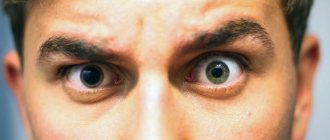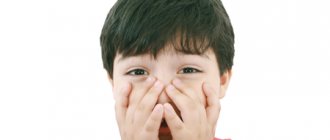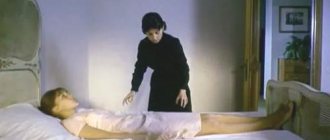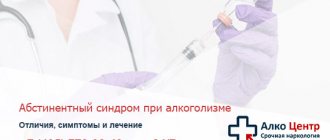Dyspraxia is a disorder of motor function and coordination of movements in a child with normal muscle tone. The deviation is associated with a violation of tactile sensations and movement planning. Often the pathology manifests itself from birth, although parents do not immediately notice it. The fact that a child has problems with articulatory motor skills is most often reported by a speech therapist after examining the child.
Experts first became aware of dyspraxia at the beginning of the last century. Initially it was called “clumsy child syndrome”, “sensory integration”, “developmental coordination disorder”, “developmental dyspraxia”. It is important not to confuse it with the term apraxia.
Main manifestations
Various degrees of dyspraxia are diagnosed in 3–6% of children, more often in boys. Many children are clumsy in early childhood, but a child with dyspraxia retains clumsiness even as an adult. Children who have been diagnosed with this disease find it difficult to perform everyday activities: they have difficulty speaking, often fall and stumble when walking, they have difficulty catching a ball in a game, maintaining balance when riding a bicycle, writing or reading something, etc. d.
Activities in which a child with dyspraxia has problems:
- speech – the work of the muscles of the articulatory apparatus is not coordinated, speech breathing is impaired;
- writing, drawing – difficulty holding a pen, brush, pencil, slow writing, long mastery of simple movements;
- reading - it is difficult to control eye movements and hold your gaze, which makes it difficult to follow the line with your eyes;
- performing basic movements when running, walking, jumping, maintaining balance;
- it is difficult to remember and reproduce the sequence of movements;
- games of high and medium mobility - children cannot catch and throw a ball, hold the attributes for the game, or use them.
Although modern medicine, and neuropathology in particular, is constantly developing innovative methods for preventing, treating and preventing disorders, dyspraxia in children is still an insufficiently studied problem.
Causes and symptoms of childhood dyspraxia
This disease can be either primary or secondary. In the first case, the causes of dyspraxia are not associated with neuropathological disorders, however, they are not easy to determine without the use of special techniques. In the second case, dyspraxia is a consequence of traumatic brain injury, cerebral palsy, other pathologies of the nervous system, or is part of the symptoms of Down syndrome, autism, and Williams syndrome.
Presumable causes of the pathology:
- Genetic predisposition - mutations of the FOXP2 gene.
- Family inheritance in a direct line, from parents.
- Pathological course of pregnancy - stressful situations, toxic effects of drugs, waste products of bacteria during viral infections, the environment, oxygen starvation of the fetus.
- Post-term or premature pregnancy.
The basis of the pathology, according to medical research, is not damage, but underdevelopment of connections between neurons. As a result, the nerve impulse arising in the cerebral cortex does not find its way to the motor system.
Symptoms of pathology may vary depending on the age of the child. In the first year of life, dyspraxia manifests itself in the form of disturbances in congenital reflexes:
- disturbances of the sucking reflex;
- problems with fixation of gaze;
- difficulty grasping objects with the palm of your hand;
- impaired coordination of movements.
In preschool age, there is increased motor activity, poor attention, difficulties with eating and maintaining balance.
Symptoms of the disorder are as follows:
- delayed development of the ability to eat and dress;
- awkwardness in movements;
- difficulty identifying the dominant hand;
- frequent falls and stumbles while walking;
- inability to catch and throw a ball, jump, stand on one leg, ride a bicycle;
- difficulties with learning to read and write;
- difficulty walking in a straight line;
- difficulty finding an answer to a simple question, although the child knows it;
- problems with long-term memory, when the child forgets the educational material studied the day before;
- inability to remember and follow complex instructions;
- difficulty determining the right and left sides;
- sleep disorders;
- sensitivity to touch.
Sometimes the pathology manifests itself only in high school age. Usually, this requires a strong emotional stimulus - excessive study load, negative attitude of peers or teachers.
In school-age children, pathology most often manifests itself in the inability to master the material. Dictations and copying are especially difficult. Children suffer from dysgraphia and dyscalculia.
All these symptoms leave an imprint on the psycho-emotional state of the child. He is unable to realize his potential because he is constantly the target of ridicule from his peers. Children become anxious, irritable, and passive. They move away from their peers and are often left alone.
Dyspraxia
Dyspraxia is translated from Latin as inaction or inactivity . The disease occurs against the background of lesions of the cerebral cortex. More often diagnosed in boys.
A child with dyspraxia is extremely vulnerable among his peers. It is difficult for him to walk, talk, read, or perform any actions.
It is right to distinguish articulatory dyspraxia as a special form of partial speech underdevelopment, since it has independent mechanisms that are different from other speech disorders, specific symptoms inherent only to it, and a characteristic type of dynamics throughout ontogenesis.
Articulatory dyspraxia is considered as an independent disorder in cases where the formation of only the sound side of speech is impaired in children. It occupies a special place among the clinical variants of speech pronunciation disorders. Articulatory dyspraxia is a condition of selective impairment of the formation of only the pronunciation side of speech, the main mechanism of which is immaturity or abnormal formation of articulatory praxis. At the same time, the elementary forms of motor functions of the articulatory apparatus are preserved (mobility, muscle tone, contractility). Violations of the sound side of speech are selective in nature and extend only to its segmental level, affecting only its consonantal components (Kornev A.N., 1989, 1993, 1994, 1999, Kornev AN. 2000). The most common cause of this condition is early residual organic brain damage. Genetically determined cases are also possible. This is confirmed by both anamnestic data and the results of a neurological examination.
In the speech therapy literature of the CIS countries, this category of disorders as an independent phenomenon has been little studied and is included either in the framework of dyslalia or in the circle of dysarthria (Grinshpun B. M., 1989, Gurovets G. V., Mayevskaya S. I., 1978, Sizova E. Ya., Makarova E.K., 1979). Perhaps the only exception is the work of I. I. Panchenko (1975), where the author, systematizing sound pronunciation disorders in children with cerebral palsy, identifies the “phonetic-apraxic form” of sound disorders. Sobotovich E.F. (1981), in a work devoted to motor alalia, identifies such a symptom complex as articulatory apraxia, but does not describe it. E. M. Mastyukova describes a similar symptom complex, which she calls “cortical dysarthria,” and identifies 3 of its varieties: with a predominance of disturbances in the articulation of front-lingual consonants, with a predominant violation of sibilants and affricates, accompanied by an active search for an articulatory structure (the author associates this with kinesthetic apraxia), with impaired articulation of affricates and their splitting, replacement of fricative sounds with stops. In the English-language literature, disorders of this type are called “developmental articulatory dyspraxia” (DAD, Morley M., 1972), verbal or “speech apraxia of development” (developmental apraxia of speech, DAS or developmental verbal apraxia, DVD, Yoss K ., Darley F, 1974).
Mixtures of sounds that have been mastered and automated in pronunciation are not specific to articulatory dyspraxia and are very rare. This is an optional symptom for articulatory dyspraxia, the mechanism of which was analyzed above. The remaining errors are obligate. The children had no deviations from the norm in the lexico-grammatical sphere. Compared to functional dyslalia, articulatory dyspraxia is a more complex and complex disorder.
It is necessary to understand that such a child is not mentally retarded. If dyspraxia is not combined with other diseases of the central nervous system, autism, Asperger's syndrome, paralysis, or pedagogical neglect, then intelligence develops at the appropriate level for age.
Types of dyspraxia
The classification of the disease depends on the type of actions that are difficult for the child to perform. The most common types of dyspraxia are:
Verbal or articulatory
Characterized by difficulties in sound pronunciation from a physiological point of view. It is difficult for a child to reproduce phrases in the correct order and form a sentence to express a thought.
Motor
The main symptoms are difficulty performing movements. It is difficult for a child to dress independently, eat, walk, write, tie shoelaces, etc.
Ophthalmological
Decreased ability to follow eye movements. It appears more often at school age, in preparation for learning. It is difficult for a preschooler to follow a line when reading only with his eyes; he always moves his head.
Appears when moving quickly. For example, walking, jumping, running.
Expressive
The child is unable to express emotions through facial expressions. The movements of the facial muscles often do not correspond to the psychological situation. For example, instead of a smile, an expression of anger, fear, etc. appears.
Ideal
The ability to act in standard, everyday situations is impaired. The child does not correlate the solution options with the current situation and cannot apply them in practice.
Constructive
It is characterized by loss in space, the patient perceives it inadequately.
Outpatient
The child cannot switch from running to slow walking and vice versa on command. Difficulties arise when changing the type of movement.
Kinesthetic
Associated with disturbances in articulation and the performance of small movements with the hands. For example, fastening buttons.
Symptoms
Manifestations of the disease depend on the individual developmental characteristics of the child. There is only a small list of the most common symptoms:
- Postural disorders
- Delayed physical development (height, body size, proportions, irregular cycles in girls, etc.)
- Developmental disorders up to 2 years of age. The child does not sit, does not crawl, etc.
- Problems concentrating on one thing
- Sleep changes
- Excessive irritability
- Difficulty with balance
- Difficulties in learning. Especially when mastering mathematics, writing, reading
- Excessive slowness when copying or copying
- Confusion of parties
- Dysgraphia
Symptoms depend on the type of disease and the age of the patient.
Causes
- Dyspraxia occurs in children for several reasons related to intrauterine development and genetic predisposition:
- Microtrauma of the brain during childbirth or the postpartum period
- Mutations
- Prematurity
- Heredity.
To date, scientists have not been able to identify the exact causes of the disease. We can talk about a combination of problems during fetal development, the influence of ecology, the lifestyle of parents, and genes.
Diagnostics
Screening for dyspraxia is carried out by psychiatrists, neurologists, ophthalmologists, and speech therapists. Tests and tasks to assess the degree of development of the disease and clarify its type are selected by the attending physician and parents.
For initial diagnosis, the following general tests are most often used:
- The child is asked to undress and get dressed.
- Draw a simple object, an animal.
- Walk alternately quickly, slowly, on tiptoes, etc.
- Touch your ear from left to right alternately on command.
- Follow objects with your eyes.
- An interview with a doctor to determine the development of speech skills, the ability to answer questions, and maintain a conversation.
- Crossing legs according to pattern, command.
- Assemble the puzzle, complete the puzzle tasks.
- Cutting out a simple shape with scissors.
Consistent difficulties in performing several diagnostic tests may lead to a diagnosis of dyspraxia.
Next, a life history is collected, and the patient is sent for detailed diagnostics to specialists.
Features of speech of children with verbal dyspraxia
Let's talk more about articulatory dyspraxia . This is one of the types of speech underdevelopment. The condition is characterized by impaired pronunciation function due to paralysis of the articulatory apparatus.
With dyspraxia associated with verbal disorders, the following deviations in sound speech are found:
- distortion of phonetic characteristics of sounds;
- phoneme substitutions;
- lack of automation of sounds;
- omissions of consonants and vowels;
- syllable rearrangements;
- mixing of mastered phonemes;
- lexico-grammatical violations;
- difficulty in constructing phrases and sentences.
Verbal dyspraxia differs from dysarthria and motor alalia in many ways. These diseases should not be confused, since the approach to correcting disorders is different.
Differences from dysarthria
- Articulatory dyspraxia differs from dysarthria in the following ways:
- The child is looking for an articulatory position
- If the phoneme or word is familiar to the child and is automated, then he is more likely to pronounce it correctly
- The presence of errors in speech depends on pronunciation conditions. If a child repeats someone else's phrase or phoneme, he will pronounce it correctly. Under conditions of emotional excitement in speech, errors occur much more often.
Differences from motor alalia
Oral dyspraxia has the following distinctive features:
- rich vocabulary;
- correct grammatical formatting of sentences and phrases;
- relative freedom in composing texts for one’s own statements;
- the ability to play with words, such as making rhymes.
Treatment and correction
Includes drug treatment and classes with specialists: neurologists, physiotherapists, speech therapists, speech pathologists. Physical activity and sports play an important role.
Correction of motor functions
In practice, the following methods for correcting sensorimotor disorders are used:
- Coordination of motor functions by constantly monitoring the execution of commands and exercises. For example, morning exercises can be turned into a treatment method. Ask the child to walk on his heels, then on his toes; replace running with jumping, stopping for a break, etc. Train your spatial orientation: ask to turn left and right
- Folding puzzles and cubes according to patterns and imagination
- Copying pictures
- Swimming
- Exercise therapy
- Massage. It can be used to develop oral praxis, fine and gross motor skills.
- Musical accompaniment in physical education
- Sewing
- Breathing gymnastics by Strelnikova teaches you to control the movement of muscles, the respiratory apparatus, and manage the process
- Occupational therapy
Correction of verbal dyspraxia
Aimed at improving the child’s verbal and articulatory function. The rehabilitation system is selected by speech therapists, psychiatrists, and speech pathologists. The task of correctional exercises is to enable the child to learn to express thoughts out loud, to understand someone else’s speech completely, and not fragmentarily, to control sound pronunciation and facial expressions during speech.
The following exercises and methods are used:
Re-education of phonetics. Aimed at automating sounds. Speech control training.
Increasing the stock of phonemes and words. These are practical exercises for composing sentences, small texts, and their articulation.
Control over facial expressions. During speech, the baby needs to repeat simple movements of the hands, head, lips to smile, etc. after the adult. Gestures must correspond to the statement. Thus, the body will participate in the process of communication with the opponent.
When diagnosing the type of dyspraxia, specialists individually select a rehabilitation system for a child of school and preschool age. With systematic training, the prognosis always remains positive.
Speech therapist advice
Classes with a specialist bring only slight improvements in the process of speaking and social adaptation of the child. The main burden lies with the parents. By studying at home, following the advice of speech therapists, you will achieve maximum effect in the treatment of dyspraxia.
What you need to pay special attention to:
- Play, don't study. It is important for a preschooler to understand that he is still a child. Play is the leading type of his activity. Teach, train, correct violations during the game. May it be fun and interesting for you and your baby.
- Develop not only correct speaking, but also other abilities of the child. For example, coordination of movement develops well while feeling objects, drawing, and catching up.
- Develop fine motor skills
- Draw, sculpt, assemble mosaics
- Don’t forget about articulation, breathing, finger gymnastics. For training, you can use the methods of Strelnikova, Buteyko, Tolkacheva
Tips for parents:
There is no panacea for dyspraxia in childhood. Parents should be patient and follow the advice of teachers and doctors. Learn yourself and instill in your child the following skills:
- rejoice at every success, praise your child more often
- do not rush your child when completing tasks
- pay attention to the little things
- do not remind your preschooler about failures
- set clear and accessible goals for your child
- require tasks to be completed
- select lesson materials based on your child’s preferences
- complicate the tasks gradually, do not rush to tackle the most difficult at the beginning of the journey.
A diagnosis of dyspraxia is not a death sentence. You shouldn’t withdraw into yourself and lower your child’s self-esteem. Most symptoms and manifestations of diseases can be eliminated in childhood. Your child needs your help to successfully adapt to adult life.
Sources:
https://ourkids.ru
https://orechi.ru
Kornev A.N.. Fundamentals of speech pathology in childhood: clinical and psychological aspects. - SPb.: Speech. — 380 s: ill.. 2006
Self-diagnosis methods
It is very important to promptly draw the attention of specialists to this problem, because in preschool age the development of movements and the development of the psyche are closely related to each other. A lag in any area entails a distorted development of other personality traits. It is important to arrive at the threshold of schooling with maximum compensation for dyspraxia.
There is a simple way to initially diagnose dyspraxia that can be done at home - the jump test. You need to jump on two legs, accompanied by the count “one-two-three-four”, changing the movements of the legs in a certain sequence:
- one - legs to the sides;
- two – legs crossed (left leg in front of right);
- three – legs to the sides;
- four - legs crossed (right leg in front of left).
Signs of trouble:
- the child cannot jump according to the pattern suggested by the adult;
- he is unable to maintain the rhythm set by the score;
- crossing his legs, he turns his pelvis.
This diagnostic method is quite accurate and can be used from 4–5 years of age.
Bike check
Symptoms vary depending on the age of the child. In the first year of life, dyspraxia manifests itself in the form of disturbances in the sucking reflex, coordination of movements, problems with fixation of gaze and grasping objects with the palm of the hand. In preschool age, pay attention to difficulties with eating and maintaining balance. The child finds it difficult to walk in a straight line, jump, stand on one leg, ride a bicycle, cannot determine the leading hand, remember and follow complex instructions.
Sometimes pathology manifests itself only in high school age due to stress, heavy workload, problems in relationships with peers or teachers. In schoolchildren, it manifests itself in the inability to master the material, write a dictation well, or simply copy the text. Because of this, the child’s psycho-emotional state is disrupted, he becomes anxious, irritable, and passive.
Treatment methods
To correct dyspraxia, modern innovative techniques using kinesiotherapy are used:
- stabilometry method with bioactive connection;
- dynamic correction with reflex-loading devices “Gravistat”, “Adelie”, “Graviton”;
- passive vestibular training using a computer stand;
- electrical stimulation of muscles;
- computer video analysis of movements;
- transcranial polarization of the brain.
Simultaneously with similar methods, pharmacological therapy with cerebroprotectors of nootropic action is used: Cytoflavin, Actovegin, Cortexin, Lecithin, Glycine, Semax, Gliatilin.
General therapeutic measures are highly effective - physical therapy, psychological and speech therapy correction. Much attention is paid to restoring the function of balance and basic movements, for which mobile and finger games and elements of sports games are used.
When treating verbal dyspraxia, the speech therapist chooses a special system of exercises for the child, one part of which is aimed at developing the pronunciation of sounds, and the second at restoring articulation.
- The first option involves teaching the child accurate articulation of phonemes. Much attention is paid to sound patterns.
- The essence of the second option is to actively train the facial muscles responsible for articulation. At the beginning of therapy, the baby imitates the elementary movements of the lips and tongue, the description of which is wrapped in a fairy tale plot (“The Tale of the Merry Tongue”). Upon completion of the correction, he must independently reproduce a sequence of several movements.
Children with dyspraxia are encouraged to participate in group gymnastics classes. They perfectly develop the vestibular apparatus, and the child gains control over his movements. Games with musical accompaniment are very useful. While playing them, children will feel the rhythm, which allows them to improve body control and coordination.









